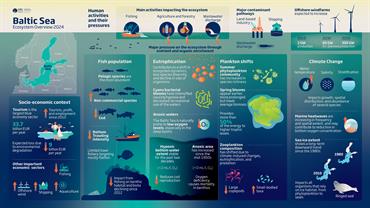The Baltic Sea is one of the largest brackish water bodies in the world, covering 420 000 km2. It is a semi-enclosed shallow
sea with an average depth of 60 m, where one third of the area is less than 30 m deep. This ecoregion has many islands and a long and diverse coastline, especially in the northern areas. It is characterized by strong temperature and salinity gradients, from relatively warmer and saline waters in the southwestern part to cold and almost freshwater in the northernmost parts.
Many species and habitats of the Baltic Sea are not in good condition, according to recent assessments. This affects foodweb functionality, reduces the resilience and resistance against further environmental changes, and diminishes prospects for socioeconomic benefits, including fishing opportunities.

Click image to view Baltic Sea ecosystem overview infographic
Key Signals
Human activities and their pressures
- While fishing is the main activity impacting the ecosystem via selective extraction of species, agriculture and forestry, together with wastewater discharge, pose the major pressure on the ecosystem through nutrient and organic enrichment. The effects of nutrient enrichment and fisheries are widespread in the ecoregion.
- Input pathways and types of contaminating compounds are diverse and widespread. This pressure results from several human activities, the most important being shipping (52%); wastewater discharge (26%); and land-based industry, including oil and gas extraction and refining (20%). The effects of contaminants on biota can be widespread and long-term and may be cumulative. Several emerging persistent organic contaminants are now of high concern in the Baltic Sea.
- Pressure caused by offshore windfarms is currently low but is expected to increase with the ongoing transition to renewable energy. The development of numerous large offshore energy production sites is likely to have implications for marine spatial planning, including the location and design of marine protected areas (MPAs); as well as for human activities, such as shipping and commercial fishery.
State of the ecosystem
- The Baltic Sea is naturally prone to low oxygen conditions, especially in the deep basins. While the extent of hypoxic bottom water (< 2 ml/L O2) has been largely stable for the past two decades, the extent of the anoxic area (< 0 ml/L O2) has increased since the mid-1990s, partly because of eutrophication.
- A shift towards earlier, more prolonged spring blooms (but with lower average biomass) has taken place in the central Baltic Sea over the past 20 years. Summer phytoplankton community composition has gone through a gradual shift towards an increase in species richness, partly because of anthropogenic stressors. These changes have subsequent effects on ecosystem functions.
- Zooplankton composition has shifted because of climate-induced changes, eutrophication, and predation, leading to a decline in large copepods and an increase in small-bodied cladocerans and rotifers. This shift, along with seasonal abundance variations driven by temperature and ice conditions, impacts sub-basins differently and has led to a long-term decrease in zooplankton size across the ecoregion.
- The reduction in cod (Gadus morhua) stocks has led to the release in predation pressure on the fish community. Pelagic species strongly dominate the fish community, with sprat (Sprattus sprattus) dominating in the southern Baltic. The non-commercial three-spined stickleback (Gasterosteus aculeatus) has increased in the past decade. The increasing stickleback densities have resulted in impaired recruitment of piscivorous fish and enhanced the effects of eutrophication through promoting the production of filamentous algae.
- Average bottom-fishing intensity has decreased significantly since 2013, owing to the poor status of the cod stocks. Only a limited trawl fishery, targeting mostly flatfish, is currently allowed. Average impact on benthic habitat and associated biota from bottom trawling has been low and declining since 2012.
- The Baltic Sea harbour porpoise (Phocoena phocoena) remains in a Critically Endangered state and requires active management of the pressures threatening its survival.
Climate change
- Climate change is causing changes in water temperature, salinity, and stratification in the abiotic environment in the ecoregion. These changes affect growth, spatial distributions, and abundance of several species in the ecoregion and is likely to continue. Cascading effects are likely to occur throughout the ecosystem, with consequences to fisheries.
- Extreme climate-related events, such as heatwaves, are increasing in frequency and spatial extent in the ecoregion. The heatwaves may enhance stratification of the upper water layers in summer, leading to reductions in bottom oxygen concentration. The effects of the stratification are potentially of greater significance in shallow waters less than 20 m deep.
- The extent of sea ice shows a long-term downward trend since the 1980s. This impacts the habitat size for all organisms that rely on ice habitat, ranging from micro-organisms to the ringed seal (Pusa hispida).
Environmental and socio-economic context
- Eutrophication causes major effects on several properties of the ecosystem, including changes in plankton species composition and overall productivity of the system. Phytoplankton blooms have become more frequent and extensive through eutrophication, and cyanobacterial blooms have increased in the ecoregion since the late 1970s.
- Coastal and marine tourism is the largest blue economy sector in the ecoregion, with the estimated total recreational benefits amounting to at least 33.7 billion EUR on average per year. The number of tourists, profitability of the sector, and employment has increased over the past decade.
- Degraded environmental conditions are estimated to reduce annual recreational benefits by 9 billion EUR.
- Fishing, shipping, offshore wind energy production and aquaculture are also important but have lower economic values than tourism. Energy production and aquaculture are growing industries, while the fisheries industry is decreasing.

